We independently evaluate all recommended products and services. Any products or services put forward appear in no particular order. If you click on links we provide, we may receive compensation.
What brings me joy is finding new stuff, interesting stuff, weird stuff – stuff you’ve never heard of. For the same reason that I can’t feign interest in the latest multicolored exotic steel sprint run of a Spyderco they’ve been making for twenty years, I just can’t help but seek out fresh items. A lot of the knives or tools I review are solely because they’re interesting. That’s how I wound up looking into Asher Knives, because they seemed to offer a very high-value product and it was a brand I – and it seems like many other people – had never heard of.

Key Specs: Asher Spiro
The Blade
The Spiro has a 3.2” long drop point blade, the tip lining up perfectly with the center of the pivot, making it a great all-purpose blade – a jack of all trades type of blade shape. It has a medium height flat grind with a hollow swedge along the curved spine, which thins the material out behind the tip to give it better geometry for piercing cuts. Blade stock is approximately 0.09” thick across the spine, so even though the flat grind doesn’t go all the way up, it has less blade stock to work against for slicing ability. This is a great do-everything blade, it probably won’t be the best at every task but it’s still my favorite overall blade shape.
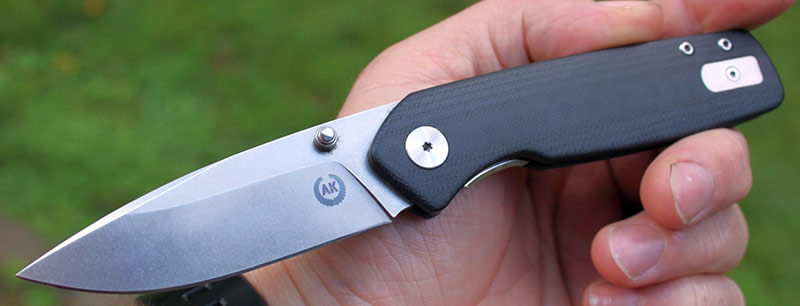
Blade steel on the Spiro is stonewashed CPM S35VN, and Asher themselves say the steel is independently verified and Rockwell tested after having supplier issues in the past. Crucible CPM S35VN is a powdered metallurgy steel that was designed as an improvement to CPM S30V, using niobium in place of some of the vanadium boosts the toughness of the steel (the ability to resist edge chipping) while retaining the good edge retention and corrosion resistance of S30V. It’s also easier to machine, a benefit mostly to manufacturers not consumers. S35VN is gradually being superseded by S45VN, which came out in fall of 2019, but it still is an excellent steel for EDC use as it balances good toughness and edge retention while being extremely corrosion resistant.
Deployment & Lockup
The Spiro has got a very impressive deployment, It must be said – a combination of a medium detent, caged ceramic ball bearings in the pivot, and a well-positioned thumb stud. I’ve always been confused by the relative rarity of thumb-stud deployment knives with bearing pivots – it’s not like people who prefer thumb studs don’t care about deployment ease and speed compared to flippers. I was impressed with the bearing pivot/thumb stud combo in the Kizer Guru, and I like it here too – it’s so light and snappy, the stepped thumb stud giving great traction without tearing up your thumb, and a light push up and slightly to the left popping the blade out with a satisfying ‘thwack’ every time.
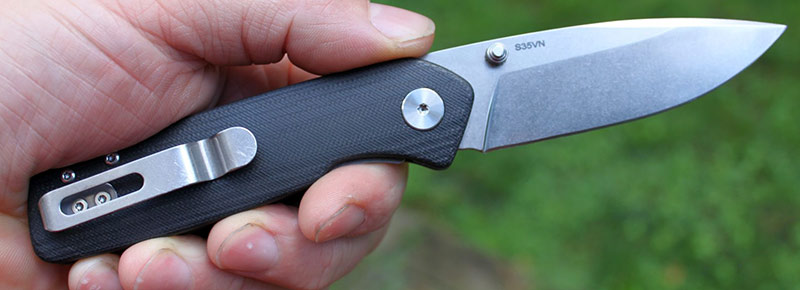
Ceramic ball bearings are a surprising inclusion at this price point, offering tighter tolerances and less wear over time than steel bearings, as well as no worries about corrosion building up in the bearing cassette. The smooth pivot also makes the knife much easier to close – which is a benefit to those familiar with bearing pivots, but a detriment to those who aren’t (a knife that closes easily is a knife that cuts you easily). Drop shut action is just not on my list of expectations for a $75, but its here, and that’s pretty cool.
Lockup is perfect, a solid thumb flick settling the stainless lock bar at about 40% lockup, and no vertical or horizontal blade play even after a month of daily use and fidgeting. I also never experienced any lock stick, a sign that the OEM for these knives knows what they’re doing in terms of lock face geometry. The Spiro uses an external lock pin to locate the blade in open and closed position for strength.
Features, Fit & Finish
The Spiro seems like a pretty plain knife at first glance, but the closer you look the more interesting details you find. The most noticeable thing for me is how light the knife is vs how chunky it looks – it only weighs 3.4 ounces. This is mainly due to the nested and skeletonized liners, as well as the open back construction. The Spiro has a semi-transparent G10 backspacer, which is a neat touch. The knife is held together with four body screws (two on each side) as well as a Chicago-style pivot screw with oversized hardware on both sides, a broad polished disc to bling things up a bit.
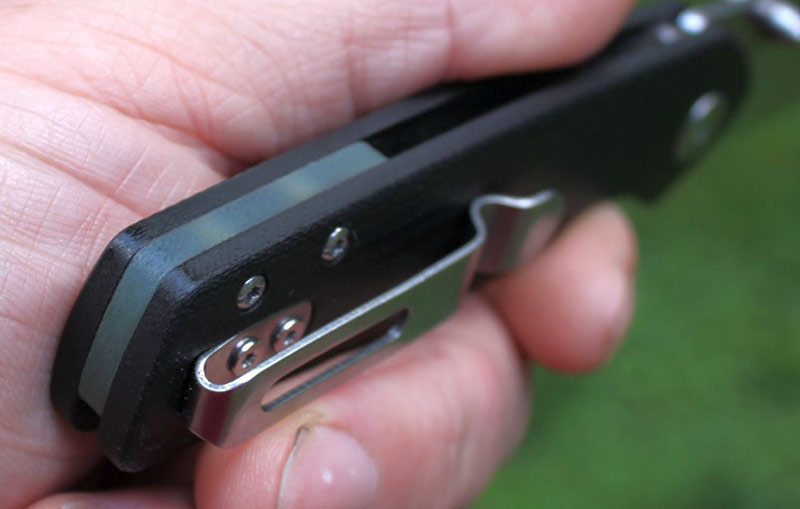
Scales are G10 that are contoured towards the edges, with a smooth finish and faux-micarta look to them, which completely wrap around the nested stainless liners. The pocket clip is a wide bent steel deep carry clip, with a very steep approach angle and a U-shaped contact patch, held in place by two screws and located by an oval-shaped cutout on the scale. The Spiro also has a blanking plate to fill in the hole on the opposite scale, held in place by a single screw and which is able to be swapped around to the other side when changing the clip position over for left hand carry. The clip is only configured for tip-up positions, which is fine by me. Since the Spiro has a reversible pocket clip and has mirrored thumb studs, we’ll call it “mostly ambidextrous” due to the right handed nature of the lock release.
Fit and finish is, again, surprisingly nice for a knife at this price point. A number of little details gradually came to my attention while I was using it, and perhaps the best is the detailed bevel on the thumb stud. You don’t even notice it at first, but the very top of the stepped thumb stud is beveled down ever so slightly in the direction your thumb pad hits it, and is lightly polished as well, so the stud doesn’t end up chewing up your thumb while maintaining good traction. The other thing I really like is the polished edge on the lockbar release, which makes closing the knife smoother and less likely to beat up your thumb. I don’t know if these little touches are done at the OEM or at Asher’s facility in Pennsylvania (as final assembly is done by hand before they’re shipped out) but it’s mighty nice. In fact the whole treatment of the lock bar – where all of it but the lockbar release is nested in the scales – is a nice touch as well, as is the fully nested liner on the show side scale.

The usual hallmarks of quality fit and finish are here, even blade centering when closed – which I’ve never thought was super important, but it’s dead even between the scales. The backspacer is also level with the surface of the scales. If you’re really OCD it might bother you that the pocket clip blanking plate is flat but the scales are contoured. But, you know, this isn’t a Shirogorov.
Field Test
I’m really fond of knives like these – a good mid-size general purpose knife that’s good at everything, and not so specialized or so precious that you hesitate to use it for actually cutting stuff. It’s a great size and weight, so it carries well, especially with that wide deep carry clip – with just the very tip of the handle protruding from the pocket. Any knife with contoured scales is going to take up more pocket real estate that a slab handled knife, but you have to decide if that trade-off is worth the better ergonomics. For me it is, as I’ll just carry other small objects in the right front pocket instead of my phone or keys. At 4.2” closed and 0.44” across, it’s not a ton of real estate anyway, and it stays in place very firmly thanks to strong spring tension from the clip.
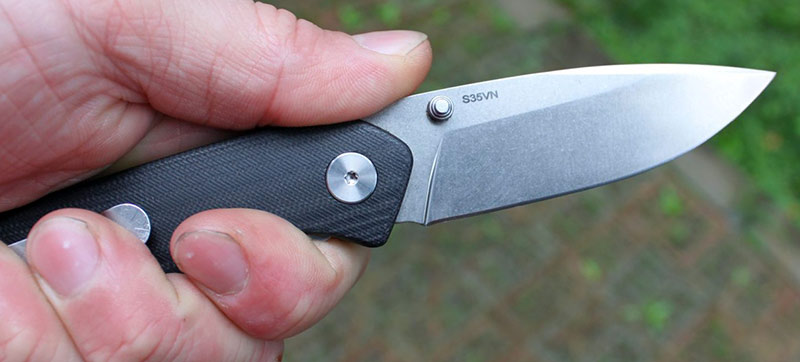
The clip itself isn’t an unbridled success, the steep entry angle and high profile meaning it’s very prone to catching on car doors, door frames, steering wheels, and anything else you don’t want to drag a pocket clip across. It never bent in my time using it, so it’s very strong, but the paint scraping was a nuisance, and it did acquire a lot of scratches – probably my fault for lying on my side on a textured concrete floor in my day job.
In use, the Spiro quickly worked its way into my daily rotation. Especially with the aforementioned injury rendering my right index finger incapable of operating flippers, I came to appreciate the simplicity and accessibility of the thumb stud opener, the smooth pivot bearing, and the easy liner lock. My finger’s getting better but I’m still using the Spiro nearly every day at work, where the stout drop point blade shape makes the knife adept at piercing plastic bags several at a time and cutting zip ties and paper tape.

The handle shape is neutral but well formed – at no point did I ever find myself saying “Gee, I wish this knife had a bunch of pointed jimping for traction.” It’s not great for cutting up food as there’s no belly to the blade, but that’s never stopped me from slicing an apple or a sandwich up before. And the tip being level with the pivot makes it more natural for cutting the foil seals off of bottles, using a pinch grip with the thumb and middle finger on the pivot and the index finger on the spine. Just a great all-around general purpose knife.
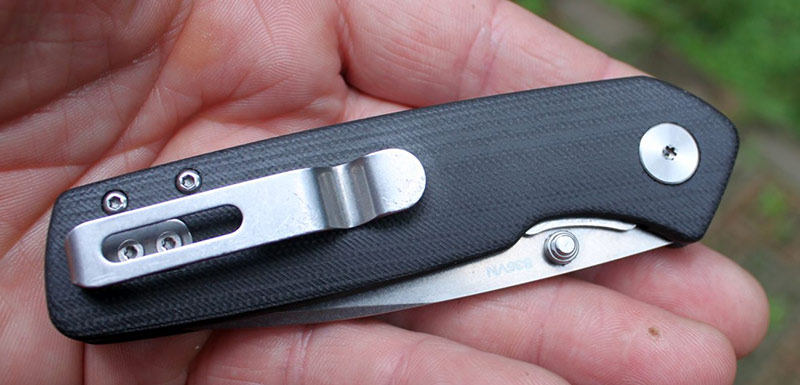
Since getting a Work Sharp Knife & Tool Sharpener Mk2, I’ve found myself using that to sharpen a lot of my knives that I’m not super particular about – knives I mostly use at work at tools, the powered sharpener makes quick work of even harder steels like S35VN and puts a keen edge on. I’ve yet to notice any chips in the edge even after going through dirty zip-ties and breaking down cardboard. The only thing wrong with S35VN is that there’s a newer powdered steel that’s replacing it – so if you don’t care about having the latest thing, this is still arguably the best steel for a daily carry work knife.
Alternatives
All these knives available at BladeHQ.
At ~$75 MSRP, the Spiro represents remarkable value for the money. If you wanted a US-built knife this size with these materials, it’s going to cost a good bit more – a Spyderco Paramilitary 2 in S35VN and brown G10 is $100 on top of the Spiro. Same with a ZT 0450.In fact, if you search on Blade HQ for folding knives, 3-3.49” blade, thumb stud, with CPM S35VN, and under $100, there are a grand total of nine – and as of this time four of them are out of stock.
So what are they? Well, three of them are variants of the Civivi Pintail – another brand that’s off the charts in terms of value for money, being the entry level line of WE Knives. The Pintail features a 3” hollow ground drop point in S35VN, and flipper or thumb stud opening via a ball bearing pivot. Micarta handles in a variety of colors are a nice touch, but it does have the same vaguely disappointing pocket clip as every other Civivi. It’s usefully lighter than the Spiro: 2.76 ounces to 3.4, but it’s also smaller, coming in at 7” overall when open. Still, hard to go wrong at ~$85.

The second is the BladeHQ exclusive CJRB Feldspar, with natural jade green G10 scales, a black coated 3” drop point in S35VN, also using a thumb stud with bearings and a liner lock to open. It’s a good bit lighter than the Spiro at 2.67 ounces, but the handle and blade themselves are much slimmer. CJRB is the entry level line of Artisan Cutlery, another brand making high-end stuff in China who wanted to get into the more affordable market with a splash. Availability will be the issue with a dealer exclusive, but it was available at the time of writing for ~$75, putting it on very level footing with the Spiro.

The third? Well, if you’ve been reading reviews here at Knife Informer for long enough, you know it’s the SOG Terminus XR in carbon fiber, a knife which seems to find itself in the comparable set for nearly every knife I review. This is because it’s great: 3” satin finished drop point in S35VN, insanely snappy deployment via the XR lock which combines a bearing pivot with a sprung bar-style lock, deeply textured carbon fiber handles, it’s a real EDC champion for $85. It weighs a similar 3.32 ounces, but if you want an even lighter one there’s the new Terminus XR LTE which is full carbon-fiber construction (no steel liners) and 2.35 ounces for $140. That’s a story for another day.

Of course, if you want to talk about value, well: you can get two Ontario Rat’s for the price of one Spiro. Sure, it doesn’t have the premium steel, or the ball bearings, or the slick G10 scales, but you could actually get a small and large combo (Rat 1 D2: $39, Rat 2 D2: $37) for the price of the Spiro and pick which one suits your day’s cutting needs better in the morning. The RAT is a legend in the EDC community for a reason, offering solid construction, easy thumb-stud opening, hard-wearing D2 steel, and an everyman price tag to anyone who wants a knife. I’m not saying two RAT’s are better than one Spiro, but it is food for thought.
Wrap-Up
Where did Asher Knives even come from? They’ve just poked their head into the market and have already put out what seems like a home run for a budget knife in the Spiro – this knife offers an insane amount of value and build quality for a $75 EDC option. They’ve also got several other models of interest, including the Nomad which has a bar-style lock or a framelock, as well as the Flashback, which is a budget take on a modern traditional pocket knife, with a trapper-style blade but a flipper opening via bearings and a translucent G10 handle scale. Lots of cool stuff and all under $100 has my attention, so I’d say based on the experience with the Spiro that Asher Knives is a brand to keep an eye on.
- Incredible value for money, slick bearing pivot opening via thumb stud, solid build quality, lots of nice little details
- Paint scraper pocket clip, limited availability from one source
Asher Spiro
Quality/Performance - 71%
Value for Money - 77%
74%
A real serious challenger in the budget EDC market from a brand no one’s heard of – yet.





